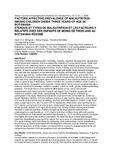| dc.identifier.citation | Mahgoub, S,E.O. et al (2006) Factors affecting prevalence of malnutrition among children under the three years of age in Botswana, African Journal of Food Agriculture Nutrition and Development, Vol. 6, No. 1, pp. 1-15 | en_US |
| dc.description.abstract | Malnutrition affects physical growth, morbidity, mortality, cognitive development, reproduction, and physical work capacity, and it consequently impacts on human performance, health and survival. It is an underlying factor in many diseases for both children and adults, and is particularly prevalent in developing countries, where it affects one out of every 3 preschoolage
children. A well-nourished child is one whose weight and height measurements compare
very well with the standard normal distribution of heights and weights of healthy children of the same age and sex. Factors that contribute to malnutrition are many and varied. The
objective of the present study is to evaluate the level of malnutrition and the impact of some socio-economic and demographic factors of households on the nutritional status of children
under 3 years of age in Botswana. Factors included: the number of children under 3 years of age in the family, occupation of the parents, marital status, family income, parental education,
maternal nutritional knowledge, residence location (urban or rural), gender, and breastfeeding practices. The study was a cross-sectional descriptive survey using a structured questionnaire and measurements of weight and height. Four hundred households and mothers of children under three, representing the 23 Health Regions of Botswana, participated in the study. Reference standards used were those of the National Center for
Health Statistics (NCHS). EPI Info software (version 5) was used for data entry and analysis. The results show that the level of wasting, stunting, and underweight in children under three
years of age was 5.5 %, 38.7 %, and 15.6 % respectively. Malnutrition was significantly (p < 0.01) higher among boys than among girls. Underweight was less prevalent among children whose parents worked in the agricultural sector than among children whose parents were
involved in informal business. Children brought up by single parents suffered from underweight to a significantly (p < 0.01) higher level than children living with both parents. The prevalence of underweight decreased significantly (p < 0.01) as family income increased. The higher the level of the mother’s education, the lower the level of child underweight
observed. Breastfeeding was found to reduce the occurrence of underweight among children. The study findings imply that efforts for redressing child undernutrition issues in Botswana
should focus on factors associated with development outcomes such as maternal income, maternal education, and the creation of employment or economic engagements that do not compromise important child care practices such as breastfeeding. | en_US |

